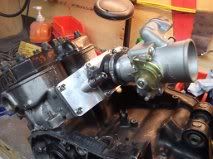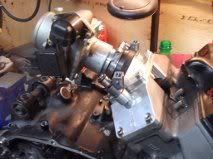The problem as I see it with adjusting the AFR trying to simulate a PJ being switched off is that this has two effects on the result.
It will increase the temp seen by the pipe, but I believe also the code does a calculation of the energy available in the fuel, and adjusts the power
that quantity will deliver - maybe in this case the two counteract each other exactly.
This is because max power is seen down at a rich mixture,around 12:1, closer to stoichiometric there is less power available, in theory and reality.
But the other thing you should realise is that although a solenoid powerjet is reducing the fuel delivered to the engine, it
is actually correcting the natural,progressively richening mixture coming from the carb, not reducing the AFR below what is was previously.
I will ask Neels about a workaround, but my reaction would be to use the pipe wall temp/rpm input screen,to increase the average temp in the pipe after a set rpm.
Going from a " normal " 50* wall temp to a 150* wall temp at 12,000 will for sure have the desired effect on the overev.
In reality the temp will increase gradually, so a temp ramp over say 1000rpm would simulate reality better.
I dont know if the code interpolates temp between the set points.
Ive got a thing thats unique and new.To prove it I'll have the last laugh on you.Cause instead of one head I got two.And you know two heads are better than one.







 Reply With Quote
Reply With Quote





 .
.
 )
)

Bookmarks